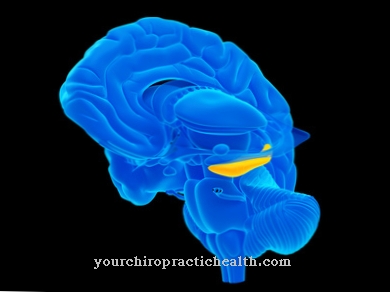The Arousal level corresponds to the level of activation of the central nervous system (CNS) and is associated with alertness, alertness and willingness to react. A medium level of excitement is the basis for maximum performance. If negative arousal persists, distress and sometimes phenomena such as burnout syndrome arise.
What is the arousal level?

According to the chain of perception, the perception of external stimuli results in a reaction to what is perceived in the last step. The ability to react to the external environment thus depends significantly on a person's ability to perceive. Functioning sensory systems create the basis for this ability to react.
However, people react more or less well to stimuli from their environment. How well a person can react to stimuli and process them is determined by their current level of arousal. This 'level of arousal' is the level of physiological arousal or activation of a person. The activation or activation is in turn the visible readiness for a certain action. There is always an excitement connected with this willingness. The degree of activation can range from tension and increased attention to noticeable excitement and the greatest possible excitement. The extreme states of the arousal level are rigid shock and deep sleep or unconsciousness up to coma.
In addition to external stimuli and sensory impressions, internal stimuli, such as pain, are also triggers for activation. In every external stimulus situation, something changes in the level of arousal. In addition to psychological processes, neural processes also play a role in the level of arousal and its height.
Function & task
The so-called Arousal is known as a term in psychology and neurology and describes the degree of CNS activation. Attention and alertness characterize arousal as well as the resulting willingness to react. The lowest arousal level is during sleep. If, on the other hand, the sensory cells transmit pain or related states of excitement to the central nervous system, this is sometimes the highest level. Emotions such as anger, fear and sometimes sexual desire also increase the level of arousal in the central nervous system.
The arousal itself does not have an emotional component, but a biophysiologically measurable variable in the EEG, which manifests itself in different frequencies with more or less small fluctuations. The voltage recognizable in the EEG and its frequency determine the level of excitation.
To trigger arousal, sensory impulses are always required, which act on certain parts of the brain stem, trigger stimulation of the cerebral cortex and stimulate the release of the stress hormone adrenaline. From the reticular formation, the degree of arousal affects the entire organism, the vegetative nervous system and thus also the metabolism.
A high level of arousal requires general alertness and a willingness to react. A person with a high level of arousal is particularly susceptible to external stimuli of danger. The willingness to react is increased by the stress hormone adrenaline, which switches off pain and shuts down all thought processes. In this way, people are enabled to flee quickly and to fight enemies that are equally ready to react. The Yerkes-Dodson law of 1908 makes the relationship between arousal level and performance easier to understand. A person can cope with difficult tasks well up to a certain level of arousal. However, if the arousal rises above this level, general performance will decrease. With a further increase, easy tasks become unsolvable and people are hardly capable of anything.
On the other hand, a certain level of arousal is necessary in order to be able to perform any kind of performance. The highest performance is achieved by people with a medium arousal level, the so-called eustress. Above this level, fatigue, exhaustion or a breakdown can occur.
You can find your medication here
➔ Medicines for relaxation & nerve strengtheningIllnesses & ailments
Stressors increase the level of arousal. While some stressors are rated as positive, other stressors are only associated with negative ratings. Persistent arousal due to negative stressors is called distress in medical practice and can favor various clinical pictures. All stimuli that a person considers unpleasant, threatening or overwhelming are negative.
A negative evaluation of stress only occurs after frequent occurrence and the renouncement of physical compensation. Stressors whose stress cannot be coped with in a given situation also have negative effects. This is the case, for example, with stressors such as divorce, illness or even the death of family members and one's own illnesses. If the negative arousal situation cannot be resolved, a coping strategy must be conveyed to the patient.
Since an arousal inform of distress results in negative tension in the entire body and releases neurotransmitters or hormones such as the stress hormones adrenaline and noradrenaline, constant distress often changes something in the organism permanently. The affected person's attention falls. The same applies to their efficiency, which automatically drops when arousal exceeds the level of eustress.
A long-term effect of distress without suitable coping strategies can favor clinical pictures such as burnout syndrome. Burnout syndrome corresponds to a state of emotional exhaustion that is associated with permanently reduced performance and thus leads to ever greater exhaustion. A phase of idealistic enthusiasm is often followed by frustrating events that ultimately lead to disillusionment or even apathy.
In addition to burnout, a type of depression, the type of arousal described can trigger psychosomatic illnesses such as addictions or aggressiveness.



























